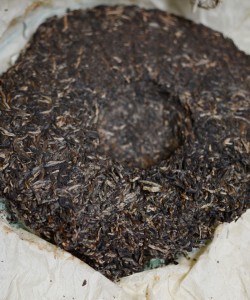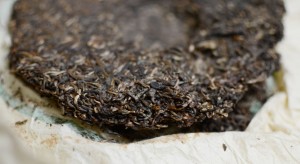Red Tea Puer, A Cautionary Tale on What to Avoid
Hongcha [red tea] pu, a phrase that I saw on a forum recently, encouraged me to document an otherwise forgettable tea that I recently came across. The cake is supposedly a late 90’s / early 2000’s (prior to wrapper dating) Mengku. I am not sure if the Yun Cha logo wrapper was original or any real indication of its true origin, so i will just use the vendor’s explanation of 2000ish Mengku as a guiding light. Hopefully this tea can serve as a cautionary tale for new puer drinkers searching out teas to age.

Some tea producers I have met have been pressing cakes out of pure tips. When I inquired as to why they would do this, they gave two reasons. First, the cake looks attractive. A cake full of gnarled buds is aesthetically more pleasing than a cake with shards of huang pian and broken leaves. Second, they can sell it for a higher price. Apparently many buyers are willing to pay a premium for such cakes. I am not amongst those buyers, as I prefer a cake with a blend of large/small leaves, and the introduction of huangpian and other riffraff has never frightened me. (see: Yexiangwang)

The leaves of this cake are tight furry curls, red and orange. The cake is almost exclusively young tips and smells like red tea from Fujian [red tea = black tea, for the purposes of this post] . I took a sample with me, and snapped some photos of the cake. It should be noted that the color and matte finish of this cake is likely due to long term Beijing storage. Beijing is extremely dry. Extended Beijing storage, especially nearly a decade, could turn most teas towards this end of the lifeless dryness spectrum.

After a rinse, the leaves smelled like a Fujian red tea. Floral, some scent of yams. No smell of aged tea or of puer is present at all. The floral smell of red tea and the floral scents in puer are usually distinguishable, but the aroma of sweet potatoes, is a more common trait of Fujian red teas. It is also entirely possible that this tea is just parading around as something it is not, but there is another possible explanation for the red tea flavors of this cake- that the tippy nature of the cake is to blame. The user Dadian [大滇] from the hk tea forums noted that in his experience:
For cakes made of only single bud tip, this also not very enduring as well as taste like red tea at mid-age. [translated from Chinese, by Apache, who passed along the forum thread]
If you concede that Beijing storage of 12 years is considered “mid-age” (and many would not), then this is a great example. Dadian thinks tippy cakes like this do tend towards a red tea character, and I agree. Furthermore, I think cakes like this do not tend to age well, with this cake is a gold star example of such crapulence. So, how was the tea?

The first tea steep went down the throat with all of the smoothness of an oversteeped bag of Lipton. Scratchy on the sides of the tongue, no kuwei [bitterness], in my notebook I wrote:
wtf is this?
Always a good sign.
I powered through until the fifth steep, at which point, I raised my white flag and surrendered, throwing the remaining tea in the trash bin and moving on to something better. I jotted down:
Could have stopped at 3.
What this tea is exactly is still not clear to me, maybe it is 2000-ish mengku puer, maybe not. Regardless of what it is, it is a victim of being too tippy and force draining dry storage. (pic from Jakub)


